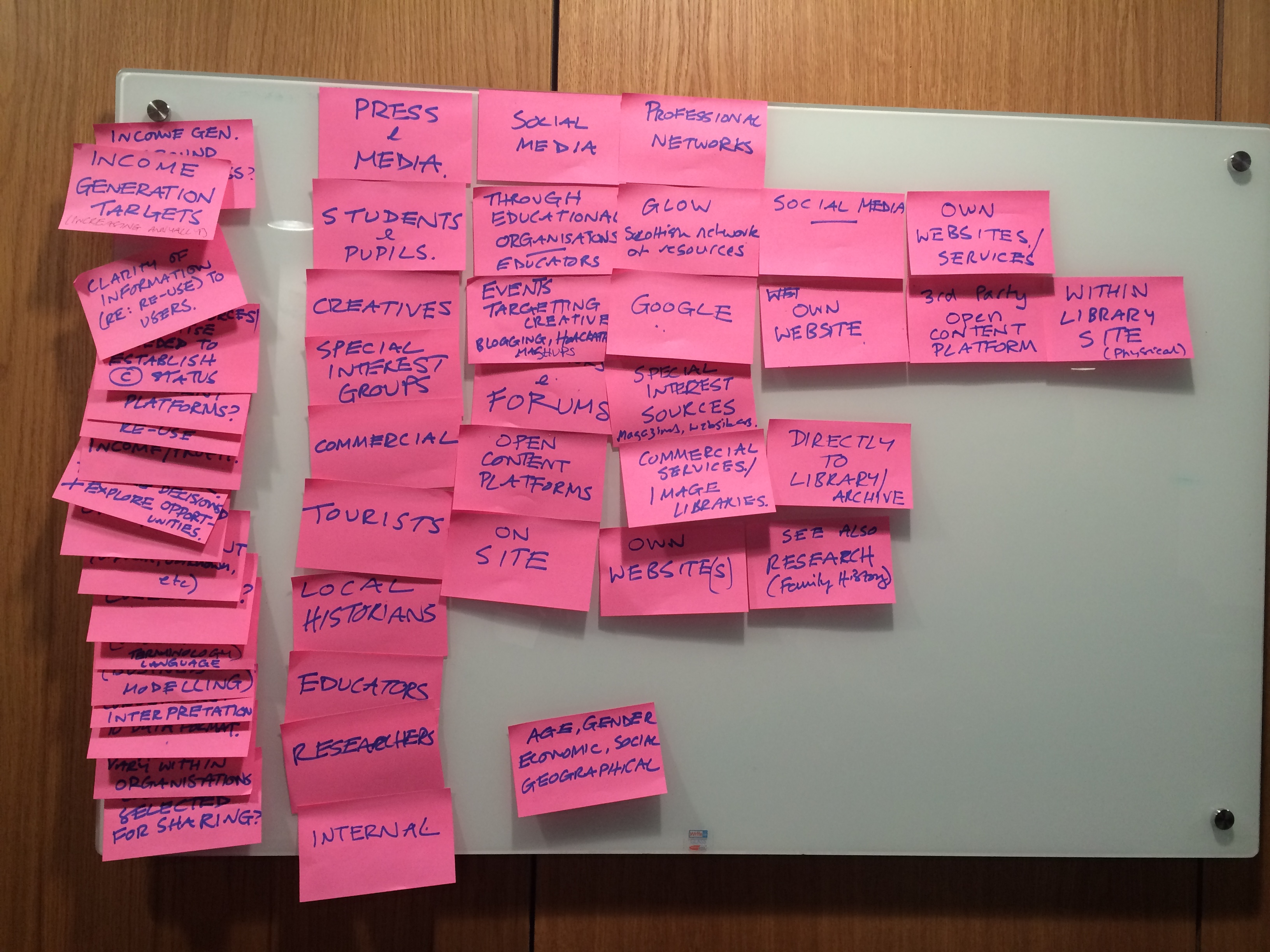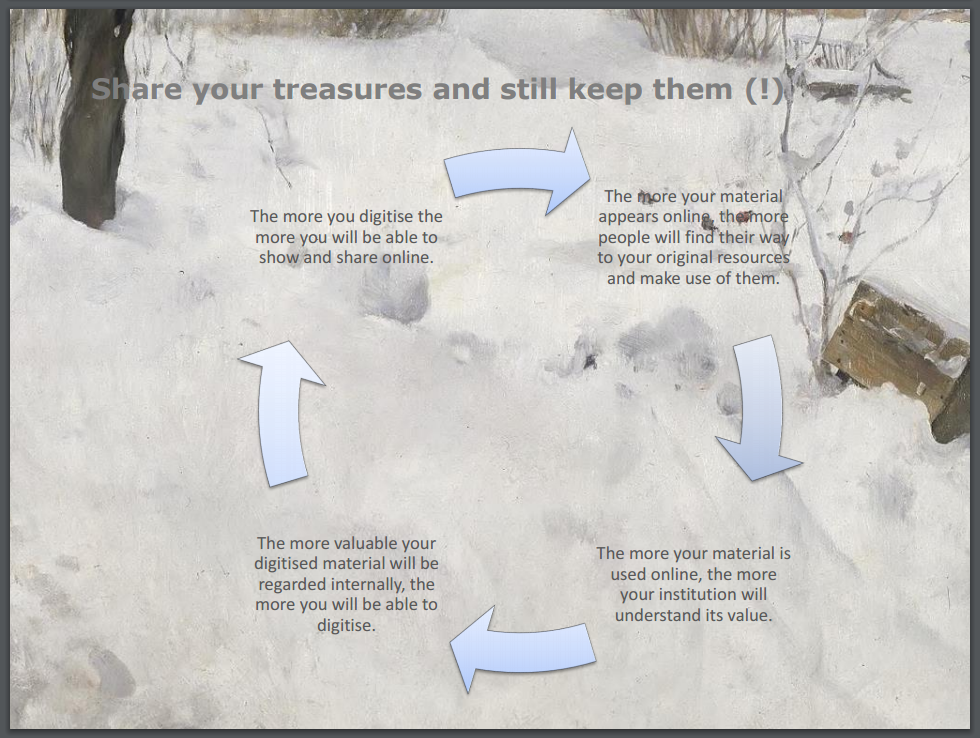An open conversation: first Europeana national workshop on sharing digital collections in Scotland
A new year! Time to collaborate on local soil - an opportunity for Europeana to reconnect with partners and meet new collections managers, digital strategists, and licensing specialists all keen to understand Europeana’s unique role as enablers and visionaries of sharing cultural content.
To encourage an open conversation, the workshops combine case studies from national organisations and network members. Discussion points focus on the opportunities and challenges of sharing digitised collections, and exploring for whom and how institutions make their collections available.
GLAMming it up in Glasgow
What better location for cultural exchange than Kelvin Hall, Glasgow, which recently reopened its doors as a hub of culture, education and sport? Twenty-two participants representing collections and archives including the specialist textiles collections of the Paisley Museum, the library and film collections held at The University of St Andrews to the more well-known art collections of The National Galleries of Scotland and the Kelvingrove Art Gallery and Museum and representatives from The National Trust for Scotland joined forces to share their experiences in managing both user expectations and enabling online access.
Adrian Murphy, our Collections Manager, and I facilitated the day. Having been in the shoes of our participants in previous roles we immediately related to our audience, ready in the wings to encourage the ambitions of those actively engaged in the room.
The day kicked off with some scene setting, outlining the value in sharing collections via the thematic channels and exhibition platforms and reinforcing the practical support, tools and guidance Europeana can offer as an advocate for best practice(s) and international standards. For a UK audience it helped to appreciate the varying European-wide approaches to copyright law in relation to access of cultural content.
Homegrown talent - the National Galleries of Scotland (NGS)
Shona Corner, Photography and Licensing Manager of NGS, then presented their recently launched online collection. Her role is central to balancing user expectations of public online access as well as for generating income. Her great overview revealed the internal processes and decision making that influenced the successful online publication of 43,088 artworks (45% of the collections). They aim to have everything online by 2024. Of particular interest is how NGS have used their Skills for the Future programme training posts to add value to achieving the discovery and engagement of their artworks.
Sharing on digital platforms - the National Library of Wales (NLW)
Dr Daffyd Tudur, Digital Access Section Manager at the NLW, demonstrated the benefits of opening up the libraries’ collections, focusing on the value of sharing public domain collections via social media platforms such as flickr commons and wikidata as well as Europeana; sometimes you don’t have to do all the work - open your collections, publish on the right platforms and lead people back to you. Digitised collections for the NLW include 90,000 graphic works, one million archival items and thousands of hours of AV material.
The advantages of collaborating to stimulate creativity was wonderfully highlighted by the use of an NLW painting as part of last year’s GifItUp competition.
One last take-away from the NLW strategy is the idea that you can build commercial opportunities around open access via well thought-out licensing models.
Coming together
Four groups. Four shades of neon paper. Time to talk. The collective positivity uncovered opportunities to collaborate internally to maximise shared expertise and to think strategically about how to make cultural content discoverable, and easily outweighed any perceived barriers.

Visible collections: it will lead people back to you
Post lunch, time to welcome our recently elected Members Council member Dr Karin Glasemann, Digital Coordinator of the Nationalmuseum, Sweden, to share her organisation’s journey of using online platforms to showcase the collections whilst the objects remain behind closed doors until 2018.
Karin is a fantastic advocate for open access, and her practical approach is in part reliant on ‘changing the mindset rather than the technology’. A shift in policy at The Swedish National Archives helped her influence the Nationalmuseum into reviewing their online image policy for two-dimensional public domain works. This resulted in 3,000 public domain works being made openly available via Wikimedia Commons and in six weeks had an impressive 400,000 views.
The discoverability of cultural content and the ongoing user engagement was neatly summarised by Karin’s ‘snowball’ of digitisation, access and sharing.

Karin Glasemann / Nationalmuseum, Sweden, CC BY SA
Identifying and reaching our audiences
As custodians of Scotland’s heritage, conversations turned to whom they are making all this cultural content visible to and how to connect. Interestingly, people approached this differently, some identifying specific sectors such as local communities and creatives and then methods of outreach. Others focused through a high-level strategic and operational lens. Discussion also centred on audience behaviour dependent on socio-economic, geographical, gender, and age perspectives.
We also highlighted the achievements of Europeana’s reuse services team to support research and education as priority audiences through initiatives such as the Europeana Challenges.
Moreover, people recognised that connecting with your audiences is a two-way street. One example is the Glasgow Street Time Travel, a small-scale experiment tested on the Kelvin Hall blog that focused on 50 photographs; they asked people to identify locations and scenes.
A connection is made
At the end of an inspiring day a clear message emerged. This workshop sparked the beginning of a conversation. People identified with a ‘start small, aim big’ approach to fold into their digital strategies. These initial steps proved successful for Faces of Europe, which allowed for institutions to ‘test the water’ and highlight a proportion of their collections using more open licences.
People want to collaborate, recognise the value in using digital platforms to promote their works and are keen to help influence sound strategic and operational decisions when prioritising digitisation of and engagement with cultural content.
Europeana can support in helping to make this happen, by direct collaboration as well as reinforcing the strength of its network as a recognised hub of knowledge, expertise and standard bearer of technical innovation and best practice.
With new members and aims for more openly licensed Scottish content in the pipeline, watch this space.
Next time… a meeting of cultural and ministerial minds in Madrid.
